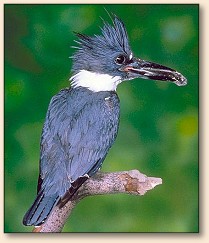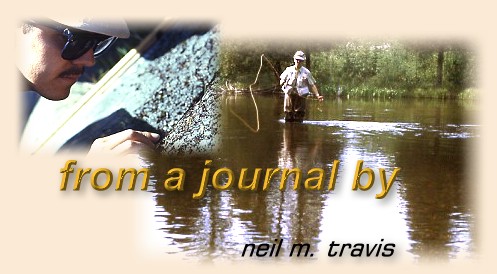Streamside Companions: Streamside Chatterbox
By Neil M. Travis, Montana
The stillness of the stream or pond is suddenly shattered
by a sound which resembles a kid kicking a can full of
rocks, a drawn out rattle that shatters the solitude like
a clap of thunder. The Belted Kingfisher has made his presence
known to one and all.
The Belted Kingfisher is a medium sized bird, about 12
inches long, with a heavy black beak and jaunty top knot
which gives them a "big headed" appearance. Both the male
and the female are blue and white. The male has a single
blue band across his white breast, while the female has a
rust colored band beneath the blue breast-band. They are
found throughout North America from Alaska to Florida and
are common around streams, lakes and ponds across the country.

Belted Kingfishers nest in burrows that they customarily
excavate themselves. These are usually dug in a sandy,
clay or gravel bank along a body of water. Where suitable
nesting sites are not adjacent to water, Kingfishers may
build their nests a long distance from water. The burrows
are normally 3 to 6 feet long, but burrows over 15 feet
long have been discovered. These burrows are used repeatedly,
so a nest site that is in use this season will likely be used
for several more years. The actual nest is placed in an
enlarged chamber at the end of the tunnel. The birds build
no actual nest, but the nesting chamber is often lined with
fish bones, fish scales and shells of crustaceans which the
birds have eaten.
Belted Kingfishers feed mostly on small fish that they capture
by diving, head first, into the water. While fish make up the
main part of their diet, they also feed on crabs, crayfish,
small amphibians, snakes, insects and small mammals. Like owls,
kingfishers disgorge pellets consisting of the indigestible
portions of their meal. These small, whitish pellets can be
found near their nesting burrows or under favorite perches.
Belted Kingfishers have favorite perches that allow them to
observe the activity of their prey, and these perches are
often jealousy guarded by the resident kingfisher. Where
suitable perches are not available, they will often hover
over the water like a hummingbird. Kingfishers prefer clear
bodies of water that are free from excessive weed growth.
Once a victim is located, the kingfisher hurls himself head
first into the water. If he is successful he will return to
his perch with his prey held securely in his beak. Then he
will smack the fish soundly against the branch, often several
times. Once satisfied that the fish is dead or thoroughly
tenderized, the kingfisher will flip the fish around and
swallow it head first. If the fish is too long to swallow
completely, the tail may remain hanging out of the beak.
While kingfishers normally prey on small fish, they
rarely represent any significant danger to healthy
trout populations. Studies have shown they chiefly
consume rough fish, but they do feed on trout and
salmon when available. In hatcheries they are a
particular problem, but this is easily overcome by
covering the raceways with screen or netting.
Like many of the creatures we encounter along our
trout waters, kingfishers are there for the same
reasons that attract us; they want to catch a fish.
Unlike us, fishing for them is an essential part of
their existence. Let's not begrudge them a trout or
two from the fertile bounty of our waters. The world
of angling would be a poorer place without their presence. ~ Neil M. Travis, Montana/Arizona
From A Journal Archives
|

